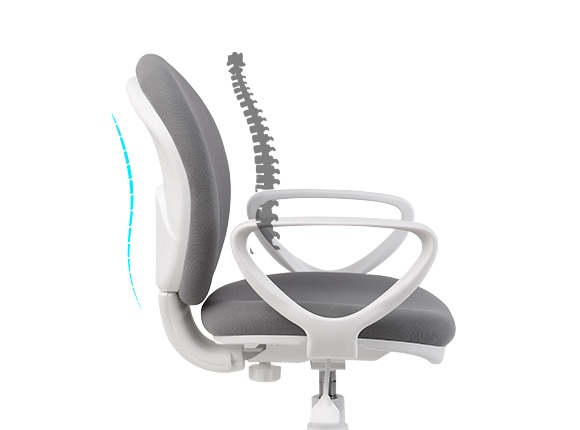A lot of children these days complain about having back pain. Many parents won't expect their children to complain about back pain, a condition usually associated with older people. However, it is estimated that around 14-24 percent of children are suffering from back pain.
Numerous scientific studies confirm that back pain is a common health condition in adolescents and children. However, in back pain in children, particularly those under 3 years, back pain may be an alarming sign for more serious pathology.
Several reasons for children's back pain are wearing heavy backpacks, intense sports activities, and obesity. Therefore, make sure you identify the warning signs in your child on time to avoid any further damage. It can become more serious if left untreated. Before talking about prevention, let's get into what factors contribute to back pain in children.
Factors Contributing to Back Pain in Children:

- A sedentary lifestyle, i.e., spending hours watching TV and playing games on computers. Make sure your child exercises regularly.
- Sports injuries occur due to excessive year-round sports activities.
- Heavy backpacks that weigh more than 10 percent of the child's body weight can contribute to back pain. Moreover, not using backpacks properly, i.e., carrying them in one hand only or on one shoulder, can put an uneven strain on the spinal vertebrae.
- Poor postures that are not sitting properly while studying or watching TV. A bad posture leads to muscle strain which causes back pain. It is believed over 60-75 percent of children suffer from non-specific back pain, meaning that their spine is normal while the back pain results from muscle strain.
- Individuals with back pain at a young age become adults with pack pain. Thus, it's vital to take care of your children back from the beginning.
- A certain pathological condition such as spondylolysis, herniated disk, Scheuermann's kyphosis, and scoliosis can significantly contribute to the child's back pain.
So, How to Prevent Back Pain in Children?
Use Backpack Correctly:
Ensure your child wears a backpack correctly. To avoid uneven stress on the spinal cord, a backpack should be worn on both shoulders uniformly. Don't allow your child to carry it with their hands too. However, the ideal solution would be using a bag with wheels on it so that it can be easily pulled along.
Reduce Computer and Television Time:

Limit the computer and television time for your child. Muscle fatigue is a common problem associated with prolonged sitting. Don't allow your child to have a sedentary lifestyle. Taking regular breaks while doing homework is necessary; having a short walk or maybe stretching the body will help ease the fatigued muscles.
Thus, ensure your kids opt for an active lifestyle rather than a sedentary one. Moreover, make sure your kids sit properly for the time they do sit. Staying active along with a proper sitting posture will enlighten their present and future. You can even buy an adjustable height desk that helps reduce muscle strain and, therefore, back pain in children.
Daily Exercise
Encourage your kids to play actively. Help your kids with at-home exercises such as bouncing on a plastic ball or maybe sitting on it. This way they will actively take part in exercise without getting bored. Improve their stability with some rolling ball exercises that help reduce back pain. Engage them in other non-weight-bearing activities such as walking, swimming, and cycling. You can learn more about the tips and exercises to improve your posture.
Managing Muscle Strain:
An extensive year-round sport can lead to back pain. If there is a physical injury, the best way to manage it is to icing the area for around 10 minutes 3 to 4 times daily. Take complete rest for a week, and avoid the sports activities. This will help reduce the strain by relieving tenderness and spasms. After a week, start gentle stretching; however, if the condition persists, seek medical advice immediately.
Correct Sitting Posture:

Make sure your child uses appropriate furniture while doing homework or using the computer. Choose the right chair and desk for a proper rest. Ensure their forearms rest comfortably and parallel to the floor. However, proper support for the feet is necessary as most desks are built for adults, so it might be too high for your child's feet to rest on the floor. Thus, Flexispot has specifically made an adjustable desk for children to solve this problem.
This prevents strain on their backs, as good posture ensures that your child's feet are not dangled in mid-air. Make sure your child sits straight in front of the screen and keyboard while using a computer. The screen top should be at their eye level, while the "B" of the keyboard needs to be in line with the belly button. Thus, a good sitting posture and concentration are ensured by a correct desk size and height that is adjustable.
Summary
Ensure your child's correct posture, concentration, and comfort with an adjustable desk. It helps maintain a good posture by ensuring that your child's feet are properly supported and your spine is well oriented. Not paying attention to the problem can have serious consequences in the long run since back pain is not uncommon among children, so parents need to ensure proper sitting arrangements. At Flexispot, you can order an adjustable desk that helps your child cope with back pain and be more productive.